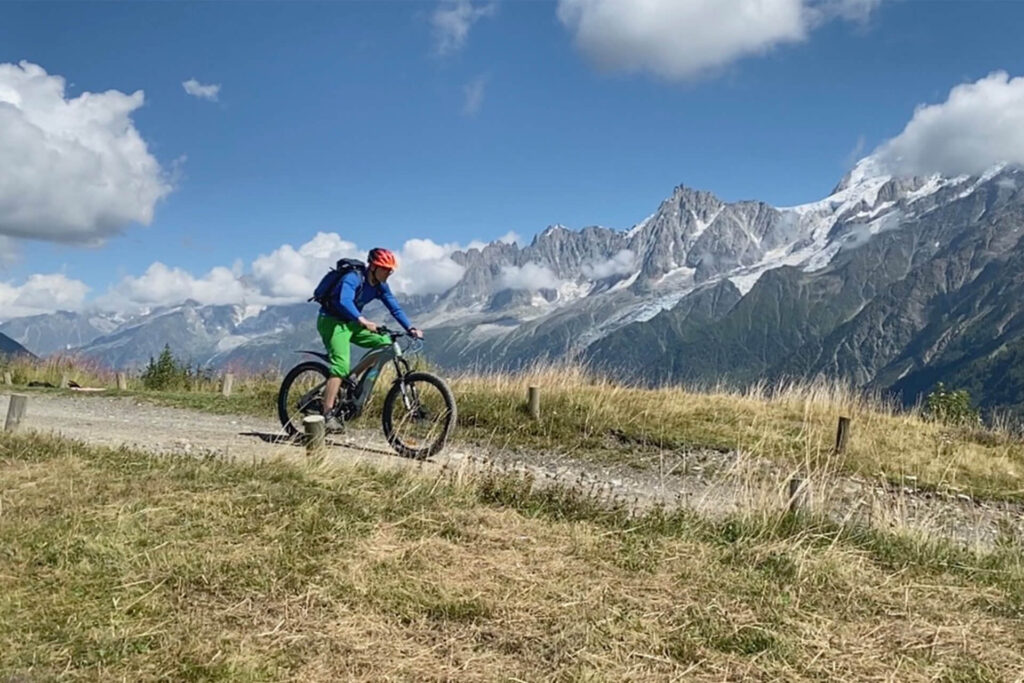This guide is designed to enlighten you about the intricacies of an electric mountain bike (eMTB) and how you can tap into its full potential to enjoy an optimal biking experience. We delve into vital topics such as gear selection and the relationship between leg power and the eBike motor, the crucial role of the […]
Guide to Efficient eBiking: Understanding and Leveraging eMTB Features

This guide is designed to enlighten you about the intricacies of an electric mountain bike (eMTB) and how you can tap into its full potential to enjoy an optimal biking experience. We delve into vital topics such as gear selection and the relationship between leg power and the eBike motor, the crucial role of the suspension system, and the appropriate application of lockout mode on eMTBs.
Additionally, we stress the significance of gaining hands-on experience on different trails to enhance your eMTB riding proficiency.
This guide is built on the premise that understanding your eBike’s features and how they work together can greatly enhance your ride, whether you’re tackling steep climbs or cruising on flat trails. So, whether you’re a newbie eBiker or an experienced rider seeking to refine your skills, this guide is for you.
In a previous article, we discussed “4 Common EMTB Riding Mistakes And How To Avoid Them.” If you haven’t read it yet, we highly recommend checking it out. It’s a handy complement to this guide, offering insightful tips that will aid you in navigating the world of eBiking more confidently and safely.
1. Gear Selection for Optimal eMTB Performance
To truly harness the power and efficiency of your eBike, understanding gear selection is vital. This not only affects how you navigate different terrains but also how effectively you can leverage the eBike’s motor and your own leg power.
The Interplay of Gears, Leg Power, and the eBike Motor
An eBike, much like a traditional bicycle, benefits significantly from the rider’s physical exertion. That said, the beauty of an eMTB lies in its ability to combine human power with the bike’s motor, facilitating a smoother and more efficient ride.
Consider a scenario where you’re facing a steep climb. If you stay in a high gear, the combination of a slow cadence (pedal rotation speed) and the resistance from the incline might overwhelm the eBike’s motor. In turn, this can sap the battery faster and make your ride more strenuous.
The key lies in utilizing lower gears at the start of your climb, or when you need extra power. Lower gears allow for a faster cadence, helping to reduce strain on the motor and maintain battery life.

Starting Low and Shifting Up
As you start your uphill climb, beginning in a lower gear allows you to pedal more rapidly, keeping your leg muscles from fatiguing and providing consistent power to assist the motor. Imagine trying to drive up a steep hill in a car without downshifting – you’d strain the engine and waste fuel. The same principle applies to eBikes.
As you gain momentum and the incline levels off, gradually shifting up to higher gears can help maintain an optimal speed without over-exerting the motor. This practice ensures that neither your legs nor the motor are overwhelmed at any point, thereby optimizing your eBike’s performance and battery life.
In summary, an eBike’s performance isn’t just determined by its motor power or the rider’s physical strength. Instead, it’s a delicate balance between these factors and the correct use of gears. Understanding this interplay and adjusting your gear selection based on terrain
2. The Crucial Role of Suspension in Elevating Electric Mountain Bike Ride Quality
The suspension system of an electric mountain bike is one of its most significant components, having a direct impact on your ride’s quality. It functions as the bike’s buffer against terrain shocks, offering comfort, control, and stability. However, a suspension that hasn’t been properly adjusted can lead to a less effective ride and pose potential challenges such as pedal strikes.
Therefore, finding the right suspension balance based on rider weight and riding style is key to an optimal eBike experience.
Electric Mountain Bike Suspension
Visualize your electric mountain bike as a compact off-road vehicle. The suspension serves as its shock absorbers, reducing the impacts of rough terrains, safeguarding the integrity of the bike frame, and ensuring a smooth, controlled ride. The electric mountain bike’s suspension – typically a combination of a front fork and a rear shock absorber – compresses when it encounters an obstacle, absorbing the shock, and providing a smoother ride.
The Fallout of Overly Soft Suspension
An excessively soft suspension setup – one that compresses too readily – can lead to several challenges, one of which is pedal strikes. This occurs when the pedal comes into contact with the ground as the suspension compresses, particularly during off-road rides on rough terrains or when pedaling through turns.
For instance, let’s picture you navigating a rocky, uneven trail. With an excessively soft suspension, the bike will sink lower, getting closer to the ground. As you pedal through, the downward movement of the pedal might cause it to hit a rock, possibly leading to a loss of control or even a fall.
Besides pedal strikes, an overly soft suspension can also result in a less effective riding experience. It may cause the bike to wallow or bob as you pedal, wasting your energy, and rendering the ride feel unresponsive or sluggish.
Achieving the Right Suspension Balance
To circumvent these issues, my investigation and testing have demonstrated that it’s essential to balance the suspension based on rider weight and riding style.
Let’s assume you are a lightweight rider who prefers relaxed, flat trail rides. In this scenario, a softer suspension setup might work well for you, providing a comfortable ride without the risk of pedal strikes.
In contrast, if you’re a heavier rider or relish aggressive mountain biking on challenging terrains, a firmer suspension would be more beneficial. It would offer better control, prevent pedal strikes, and minimize energy wastage due to suspension bobbing.
In conclusion, the role of an electric mountain bike’s suspension in shaping your ride quality is irreplaceable. It requires careful adjustment, considering the rider’s weight and riding style. A correctly set up suspension will not only make your ride more enjoyable but also safer and more efficient, regardless of the terrain you choose to conquer.

3. The Appropriate Application of Lockout Mode on Electric Mountain Bikes
Lockout mode, a feature often found on electric mountain bikes, allows riders to effectively ‘lock’ their bike’s suspension, rendering it rigid. This can be highly beneficial in certain riding situations, such as on smooth roads or during transit sections. However, it is crucial to use this feature judiciously to avoid potential damage to the suspension system.
Here’s a real-life scenario to give you a better grasp of the implications of using, or rather misusing, the lockout mode.
Imagine embarking on a day-long electric mountain biking adventure. Your route is mixed, consisting of both rugged, off-road trails and smooth, paved sections. As you start your journey on a smooth tarmac road, you decide to engage the lockout mode. Why? Because when the terrain is flat and smooth, a locked-out suspension allows for more efficient pedaling – the energy you put in goes directly into forward motion rather than being absorbed by the suspension.
Now, let’s say you reach the trailhead leading to an off-road section. This is where you must disengage the lockout mode. If you forget to do this and continue to ride on rough, rocky terrain with the lockout mode on, the lack of suspension can lead to uncomfortable jarring and potentially uncontrolled bouncing.
Moreover, the continued misuse of the lockout mode on rough terrains can cause severe damage to the suspension. The constant hammering and jolting forces the locked-out suspension components to absorb shocks they are not designed to handle, leading to premature wear and potential failure.
To give a practical example, during one of my tests, I accidentally left the lockout mode on while tackling a rocky descent. The impact from the rough terrain caused significant stress to the suspension components, leading to a failure of the rear shock absorber. The repair process was not only time-consuming but also led to a hefty repair bill.
So, the lockout mode on electric mountain bikes should be used strategically and sparingly, specifically for smoother sections of your route. It can improve your riding efficiency but misusing it could lead to expensive repairs and a compromised riding experience.
The Significance of Gaining Experience on the Trails with Your Electric Mountain Bike
As with most skills in life, proficiency in eMTB (electric mountain bike) riding doesn’t come overnight. It’s the result of consistent practice and valuable time spent traversing various types of trails. In fact, the more experience you gain on the trail with your electric mountain bike, the more your confidence and capabilities will grow. This ability to adapt and handle unexpected situations is crucial.
Take a moment to imagine you’re venturing out with your electric mountain bike for the first time. The trails are an exciting unknown, a playground waiting to be explored. However, every rock, root, or steep descent might seem intimidating. The eMTB under you, with its various power modes and sophisticated features, might feel a little overwhelming.
Now fast-forward several weeks, or even months, into the future. You’ve spent countless hours on your eMTB, tackling trails that vary in difficulty and terrain. With each ride, your understanding of your bike’s functionality has deepened. You’ve experienced firsthand the implications of poor suspension settings on a rocky trail or the consequences of incorrect gear selection on steep climbs. You’ve also enjoyed the exhilarating rush of conquering difficult paths using the optimal power mode.
This accumulated experience empowers you to anticipate the challenges you might encounter on your rides, and handle them with poise and confidence. Should you forget to disengage the lockout mode before a bumpy descent, you’d know from previous mishaps the discomfort it could cause and quickly rectify it. If your bike started feeling sluggish during a climb, your understanding of gear selection and power modes would allow you to diagnose the issue and make the necessary adjustments.
After all, as the saying goes, practice does indeed make perfect!
Guide to Efficient eBiking – Conclusion
In summary, efficient eBiking hinges on understanding and leveraging the essential features of your eMTB. From gear selection to proper use of suspension and judicious application of the lockout mode, each element plays a unique role in enhancing your riding experience.
Additionally, gaining hands-on experience on different trails will help you better comprehend and adapt to these features in real-time. Remember, your eMTB is a sophisticated machine designed to help you tackle diverse terrains, but its performance largely depends on how well you understand and use its features.
So keep exploring, keep learning, and enjoy the ride!